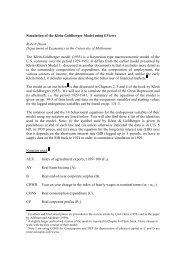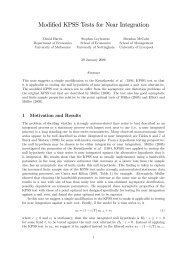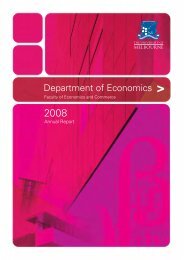Undergraduate Studies in Economics Undergraduate Studies in ...
Undergraduate Studies in Economics Undergraduate Studies in ...
Undergraduate Studies in Economics Undergraduate Studies in ...
You also want an ePaper? Increase the reach of your titles
YUMPU automatically turns print PDFs into web optimized ePapers that Google loves.
Diversity of actuarial Work<br />
Actuaries and Bank<strong>in</strong>g<br />
and F<strong>in</strong>ance<br />
Bank<strong>in</strong>g has become a more mathematical<br />
discipl<strong>in</strong>e <strong>in</strong> the last 25 years. Firstly, the paradigm<br />
has shifted from the banker us<strong>in</strong>g his judgement<br />
about a deal and a company, to us<strong>in</strong>g historical and<br />
market data to develop mathematical models that<br />
allow the assessment of risk versus return.<br />
Secondly, there has a been massive growth <strong>in</strong> the<br />
trad<strong>in</strong>g of complex derivative products <strong>in</strong> recent<br />
years. The Bank of International Settlements<br />
recently estimated that there are 27 trillion USD<br />
notional of <strong>in</strong>terest-rate derivative contracts<br />
outstand<strong>in</strong>g. Such products can only be valued<br />
by us<strong>in</strong>g complex mathematical techniques, and<br />
for this the blend of mathematical, f<strong>in</strong>ancial and<br />
personal skills of an actuary is ideal.<br />
To properly assess the risk versus return of a<br />
deal requires not just a model of the quantities<br />
underly<strong>in</strong>g the deal and its hedg<strong>in</strong>g, but also of how<br />
these quantities <strong>in</strong>teract with the bank’s exist<strong>in</strong>g<br />
portfolio. Thus one wishes to build a model of all<br />
the deals currently held and measure its risk and<br />
return profile, and compare that with the portfolio<br />
extended by add<strong>in</strong>g the new deal. To do this<br />
requires build<strong>in</strong>g models not just of the distribution<br />
of each underly<strong>in</strong>g risk exposure, but also of how<br />
they vary together. These need to be extrapolated<br />
from historical data and here actuarial skills are<br />
essential.<br />
Actuaries are <strong>in</strong>volved <strong>in</strong> the modell<strong>in</strong>g of f<strong>in</strong>ancial<br />
risks typically faced by banks and <strong>in</strong> the calculation<br />
of capital requirements for banks. This is a grow<strong>in</strong>g<br />
area for actuaries.<br />
Actuaries and<br />
Life Insurance<br />
Life <strong>in</strong>surance has been an important practice<br />
area for the actuarial profession for more than<br />
a century. In the last 20 years the life <strong>in</strong>surance<br />
<strong>in</strong>dustry has seen some radical changes with the<br />
ris<strong>in</strong>g importance of unit-l<strong>in</strong>ked contracts and the<br />
restructure of long established mutual companies.<br />
The role of the actuary <strong>in</strong> life <strong>in</strong>surance has evolved<br />
and life <strong>in</strong>surance cont<strong>in</strong>ues to be an important<br />
employer of qualified actuaries and new graduates.<br />
The bus<strong>in</strong>ess of life <strong>in</strong>surance revolves around longterm<br />
f<strong>in</strong>ancial contracts (called policies) between<br />
life <strong>in</strong>surance companies and their customers or<br />
policyholders.<br />
Life <strong>in</strong>surance policies <strong>in</strong>volve payments <strong>in</strong> the<br />
event of specified circumstances <strong>in</strong>volv<strong>in</strong>g the<br />
death or survival of nom<strong>in</strong>ated lives. For example,<br />
<strong>in</strong>dividuals with dependents will often take out a<br />
temporary contract provid<strong>in</strong>g a lump sum payment<br />
<strong>in</strong> the event of their death with<strong>in</strong> the contract<br />
period. Such a contract typically provides f<strong>in</strong>ancial<br />
security for a family <strong>in</strong> the event of<br />
the premature death of the ma<strong>in</strong> bread-w<strong>in</strong>ner.<br />
Life <strong>in</strong>surance companies would normally rely on<br />
their actuaries to calculate the appropriate charge<br />
(or premium) for contracts provid<strong>in</strong>g such death<br />
benefits. In perform<strong>in</strong>g such calculations, actuaries<br />
apply mathematical techniques <strong>in</strong>volv<strong>in</strong>g probability<br />
and compound <strong>in</strong>terest. These contracts usually<br />
<strong>in</strong>volve funds be<strong>in</strong>g set aside and actuaries use<br />
similar techniques to assess the amounts required<br />
to ensure the f<strong>in</strong>ancial <strong>in</strong>tegrity of life <strong>in</strong>surance<br />
policies.<br />
As a result of their understand<strong>in</strong>g of life <strong>in</strong>surance<br />
bus<strong>in</strong>ess actuaries are often found <strong>in</strong> senior<br />
management roles with<strong>in</strong> the <strong>in</strong>dustry or regulatory<br />
bodies.<br />
Actuaries and General Insurance<br />
General <strong>in</strong>surance is a very broad term which<br />
essentially covers all types of <strong>in</strong>surance which are<br />
not classified as life <strong>in</strong>surance. Most <strong>in</strong>dividuals<br />
will effect a general <strong>in</strong>surance policy dur<strong>in</strong>g their<br />
lifetime. Examples <strong>in</strong>clude motor vehicle <strong>in</strong>surance,<br />
home contents <strong>in</strong>surance, and travel <strong>in</strong>surance.<br />
One of the major roles an actuary plays <strong>in</strong><br />
general <strong>in</strong>surance is modell<strong>in</strong>g risks. As a simple<br />
example, consider motor vehicle <strong>in</strong>surance. A<br />
typical <strong>in</strong>surance policy covers an <strong>in</strong>dividual for<br />
one year, but when a policy is issued, the <strong>in</strong>surer<br />
does not know how many motor vehicle accidents<br />
the <strong>in</strong>dividual will have dur<strong>in</strong>g the year, or how<br />
much vehicle repairs will cost as a result of these<br />
accidents. Based on previous years’ data for similar<br />
<strong>in</strong>surance policies, an actuary will construct models<br />
both for the number of accidents an <strong>in</strong>dividual will<br />
experience and for the costs associated with these<br />
accidents. A fundamental use of such models is <strong>in</strong><br />
the pric<strong>in</strong>g of an <strong>in</strong>surance policy. The actuary must<br />
decide on the amount (known as the premium) to<br />
be paid by an <strong>in</strong>dividual for <strong>in</strong>surance cover.<br />
Another illustration of general <strong>in</strong>surance would be<br />
a policy cover<strong>in</strong>g a manufactur<strong>in</strong>g company aga<strong>in</strong>st<br />
losses aris<strong>in</strong>g from an <strong>in</strong>dustrial accident or a fire.<br />
Consider the situation where a large factory was<br />
completely destroyed by fire. The losses associated<br />
with this would run <strong>in</strong>to millions of dollars, and it<br />
would take a number of years before the <strong>in</strong>surance<br />
claim was f<strong>in</strong>ally settled as the factory was rebuilt,<br />
new mach<strong>in</strong>ery <strong>in</strong>stalled and so on. One of the<br />
tasks for an actuary would be to set a reserve level.<br />
This is an estimate, required for statutory purposes,<br />
of the cost to the <strong>in</strong>surance company of eventually<br />
settl<strong>in</strong>g the <strong>in</strong>surance claim. An actuary must also<br />
be able to perform calculations to ensure that an<br />
<strong>in</strong>surance company is solvent. Broadly speak<strong>in</strong>g,<br />
this means that the <strong>in</strong>surer has enough funds to pay<br />
<strong>in</strong>surance claims as they arise.<br />
A further role of actuaries <strong>in</strong> general <strong>in</strong>surance<br />
is <strong>in</strong> determ<strong>in</strong><strong>in</strong>g re<strong>in</strong>surance arrangements. An<br />
<strong>in</strong>surance company may wish to limit the amount<br />
it pays on an <strong>in</strong>surance claim. It can achieve this by<br />
shar<strong>in</strong>g the <strong>in</strong>surance risk with a re<strong>in</strong>surer <strong>in</strong> return<br />
for the payment of a re<strong>in</strong>surance premium. A role<br />
for the actuary is to decide on the most appropriate<br />
type of re<strong>in</strong>surance, and how much of the <strong>in</strong>surance<br />
risk should be shared with the re<strong>in</strong>surer.<br />
12 13







